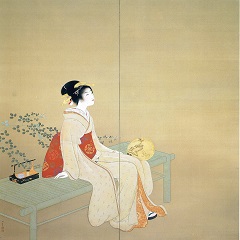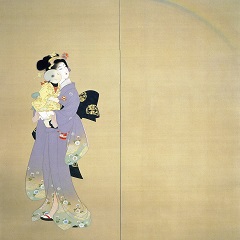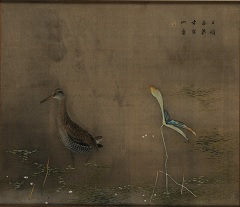Collection GalleryThe 2nd Collection Gallery Exhibition 2014-2015 (95 works in all)
Collection Gallery
HOME > Collection Gallery > The 2nd Collection Gallery Exhibition 2014-2015 (95works in all)
The 2nd Collection Gallery Exhibition 2014-2015 (95 works in all)
Exhibition Period
5. 14 (Wed.) - 7. 13 (Sun.), 2014
Overview
Our second collection gallery exhibition this year features numerous exhibits related to the special exhibitions entitled "Uemura Shoko" being held on the 3rd floor from May 27 (Tue) through July 6 (Sun).
Half of the collection gallery exhibits feature works by teachers and friends of Uemura Shoko, collected under the title, "Special Feature: Teachers and Friends of Uemura Shoko." From the entrance to the room with the skylight, works by Yoshioka Kenji and Akino Fuku, who had a deep relationship with Shoko and took leadership in establishing the Sozobijutsu Kyokai (The Society for Creation of Art), are being displayed. This display is not limited to works by these two artists, however. It also includes works by other western-style painters such as Tabuchi Yasukazu and Inokuma Gen'ichiro who temporarily collaborated with Uemura Shoko in Shin Seisaku Kyokai (Shinseisaku Art Society) when Sozobijutsu Kyokai was developed into Sogakai (The SOGA-kai Association of Japanese Painting), and Suda Kunitaro et. al. who deeply committed in Shoko's artistic career. Our regular "Nihonga (Japanese-style painting)" section features works by Shoko's mother, Uemura Shoen, works by Shoko's teacher, Nishiyama Suisho, and works by the students of Nishiyama's private painting school Seiko-sha, such as Domoto Insho and Mitani Toshiko, as well as Shoko's colleagues who studied and taught at Kyoto Municipal School of Paintings (present Kyoto City University of Arts) and later played a leading role at the Teiten (Imperial Art Academy Exhibition) or Nitten (The Japan Fine Arts Exhibition, successor of Teiten). It would be greatly appreciated if this exhibition could provide our visitors with a special opportunity to understand how Shoko's art was developed through rich artistic exchange and support.



In the "Craft" section, we introduce craftworks by ceramists and textile artists who studied and taught with Shoko under the title, "Contemporary craft artists of Uemura Shoko." Even though these works do not possess distinct avant-garde characteristics compared with works of artists who belong to the "Pan-Real Art Association" or "Sodeisha," they still retain characteristics of the "quiet struggle," as shown in their motifs and styles, aiming for creation of new art forms in the chaotic period right after the World War II. Furthermore, we continue to display selected masterpieces of Kawai Kanjiro.
The "Yoga (western-style painting)" section has continued to feature selected masterpieces of our museum collection in chronological order since we celebrated the 50th anniversary of opening of our museum last year. This time, works from the 1960s are being featured under the title, "Abstract painting in the 1960s in Japan." Various styles of western-style paintings have been selected, such as works by Isobe Yukihisa, who combined contemporary objects and motifs from old paintings such as Tawaraya Sotatsu's "Bugaku Dancers," works by Ito Takayasu, who attached ropes and wires to the surfaces of his paintings, and works by Yamada Masaaki who combined half-tone stripes. Works by Takahashi Shu, who played an active role in Rome for many years, are also being exhibited. Takahashi's retrospective exhibition is also being held at Kyoto Municipal Museum of Art from May 23 (Fri) through June 22 (Sun).
In the "Photography" section, works by Takamine Tadasu and Sawada Tomoko are being displayed under the title "Self-portrait of the 00s." Takamine's installation, "Baby Insa-dong" is a combination of words, photographs and video featuring he and his ethnic Korean wife's wedding ceremony and wedding reception. By inserting critical discourse, Takmine was able to sublimate his works to a universal reportage. Sawada's contemporary portraitures feature myriad facets of self-identity, through the use of numerous costumes and staged photography, such as her own skinhead self-portraits, exploring the meaning of one's own self-identity and one's unstable existence. The works of these two artist have one point in common; they question their relationship with the world by reflecting on themselves.
Last of all, we also feature paintings and prints by Marc Chagall, who is very popular in Japan. Born in Russia, the Jewish painter Chagall continued to question his origins as a Jew and the relationship between the surrounding world and himself. By utilizing allegorical motifs, he developed his own fantastic world of art.
Themes of Exhibition
- ・Special Feature: Teachers and Friends of UEMURA Shoko
- ・Self-portrait of the 00s
- Works by TAKAMINE Tadasu and SAWADA Tomoko - ・Contemporary Craft Artists of UEMURA Shoko
- ・Ceramic Works by KAWAI Kanjiro
- ・Abstract Paintings in 1960s in Japan
- ・Paintings and Prints by Marc Chagall
- ・[Outside] Outdoor sculpture


